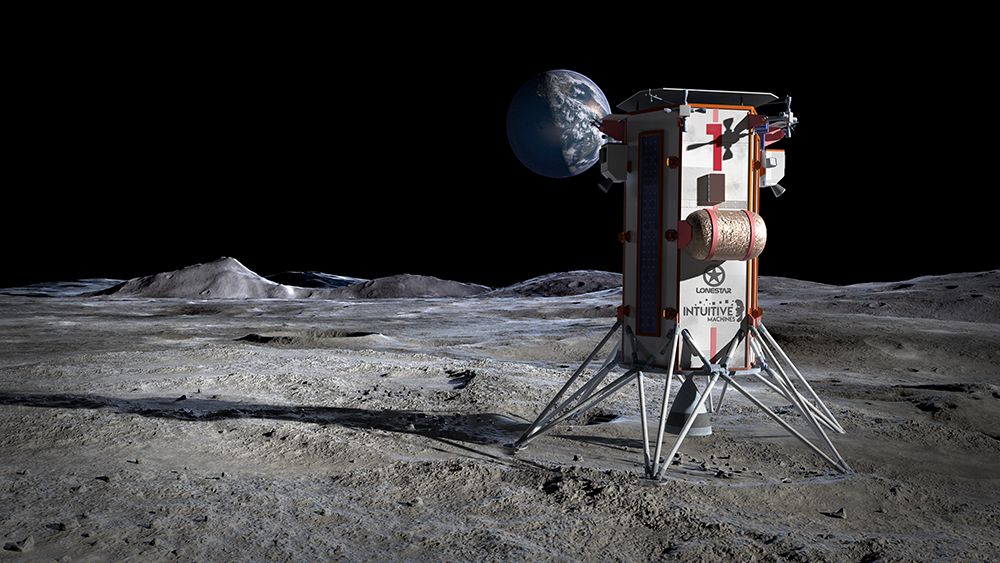TAMPA, Fla. — Cloud computing startup Lonestar said April 19 it has contracted commercial lunar lander developer Intuitive Machines to deploy a mini proof-of-concept data center on the moon next year.
The hardback novel-sized “data center in a box” is part of a series of increasingly larger payloads that Lonestar plans to install for data storage and edge processing from the lunar surface.
According to Lonestar, operating data center capabilities from the moon offers a more secure and environmentally friendly alternative to deploying energy-intensive servers on Earth.
The Florida-based venture said its initial hardware is joining IM-2, Intuitive Machines’ second mission to the moon, which aims to take a collection of government and commercial payloads to the lunar south pole aboard its Nova-C lander.
Lonestar said it has also signed a contract with Intuitive Machines to test data transfer and storage capabilities during the lander developer’s first mission, IM-1, which will attempt to land Nova-C at Oceanus Procellarum located at the western edge of the near side of the moon. These tests will use a software-only “virtual payload.”
IM-1 was previously set to launch in 2021 before launch provider SpaceX pushed the mission into the first quarter of 2022 because of its “unique mission requirements.” Further delays have pushed this Falcon 9 launch later in 2022.
IM-2 is slated to launch on a Falcon 9 in 2023 in what will be Intuitive Machines’ first dedicated launch, after previously targeting the fourth quarter of 2022.
An Intuitive Machines spokesperson said more information about the launch windows for IM-1 and IM-2 will be announced “soon.”
Funding secured
Lonestar has fully funded its IM-1 and IM-2-enabled demos with the backing of early-stage investors Scout Ventures, Seldor Capital and 2 Future Holding, according to CEO and cofounder Chris Stott.
Stott told SpaceNews that the venture is also in the “final stages” of closing a $5 million seed funding round for future data centers.
Skycorp, a California company focused on orbital logistics, is building the first data center payload for Lonestar’s proof-of-concept service.
The 1-kilogram payload will have 16 terabytes (TB) of capacity, according to Stott, who said it has passed a Preliminary Design Review and is heading to Critical Design Review.
“Our first lunar data center payload will be integrated on the IM-2 NOVA C once it has passed its Flight Readiness Review (FRR) and finished testing, as per flight milestones expected at four months prior to launch,” he said.
While the initial payload will draw power and communications from the lander, Stott said the startup aims to have a standalone data center on the moon in 2026.
Before helping to establish Lonestar in 2021, Stott cofounded U.K.-based ManSat and had led the international spectrum regulation specialist for more than two decades.
Stott said the startup has “secured S, X, and Ka-Band filings” via the United Kingdom to beam data to and from the moon to support its operations.
He said Lonestar hopes to pioneer a moon-based market for data centers to support anticipated demand for commercial, government and academic lunar missions.
Although the space-qualified equipment Lonestar plans to use “costs a little more than terrestrial counterparts,” he said it is cheaper to operate and uses “far less power.”
“The traditional costs and concerns for a terrestrial data center — power to run it, power to cool it, cost of communications — are quite different [and] almost reversed in space,” he said.
“For example, the heat generated by the equipment becomes a positive in space where we work hard to keep our equipment warm. We’re able to draw from green energy sources [solar] in space.”
Its first physical payload is a revenue-generating proof-of-concept for undisclosed customers, he said, and is only expected to last for the duration of the IM-2 mission.
The Intuitive Machines spokesperson said IM-2’s surface operations are expected to last about 11-14 days.
Future Lonestar data centers are being designed to survive the lunar night, Stott said, and aim to match the 15-20-year lifecycle of satellites in geostationary orbit.
Moon backups
Rather than compete with terrestrial data centers, Lonestar aims to complement them in the disaster recovery as a service (DRaaS) market, enabling organizations to back-up critical systems by storing them on the moon.
Stott cofounded Lonestar with Mark Matossian, a former CEO of Finnish radar satellite operator Iceye’s U.S. subsidiary and head of data center hardware manufacturing at Google.
Former ABN AMRO and Morgan Stanley banker Carol Goldstein and Del Smith, a former senior space business counsel at law firm Dentons, are also cofounders.
In December 2021, Lonestar said it worked with British software company Canonical and U.S.-based space technology consolidator Redwire to successfully test its edge data center from the International Space Station.
NASA is helping to fund Intuitive Machines’ landers. The Houston-based venture was one of the first to secure funding under the space agency’s Commercial Lunar Payload Services (CLPS) program.
CLPS is part of NASA’s Artemis lunar exploration program that has been helping attract investments in multiple startups with hopes of developing a moon-based economy.
Other companies that have announced plans to use Intuitive Machines landers to get to the moon include the Columbia Sportswear Company and time capsule venture Lunaprise.
